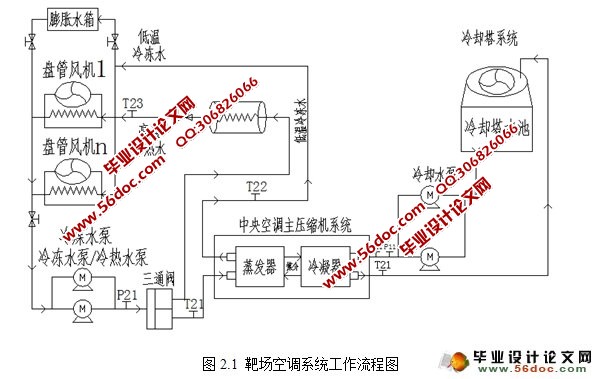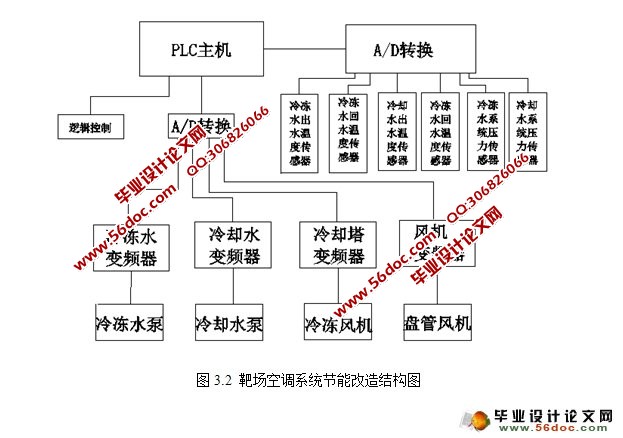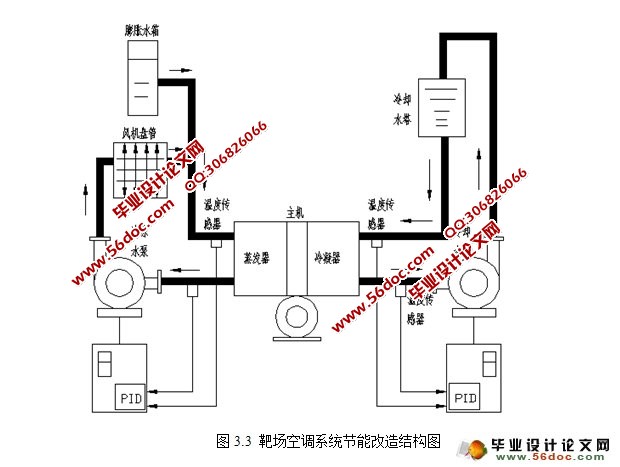基于PLC实现的靶场空调自控系统研究
无需注册登录,支付后按照提示操作即可获取该资料.
基于PLC实现的靶场空调自控系统研究(任务书,开题报告,外文翻译,进度检查表,设计说明书18400字)
摘要
随着我们国家经济的蓬勃快速发展,很多的大型建筑如雨后春笋的出现在一些城市的各个大街小巷,社会总能量消耗的大部分都在这些建筑上,这些建筑在社会上所占的能量消耗比重也越来越高,据有关的调查显示空调系统的能量消耗在这些建筑中所占的比例达到70%左右。如今的社会在供电方面不是很完善的,电价的不断上涨,资源的匮乏都是供电紧张的原因,所以如何减少能源消耗浪费和提高空调系统的运行效率就成为我们需要面对和解决的问题。
随着PLC技术和变频器的发展,采用变频调速技术不仅能使空调系统发挥更加理想的工作状态,还能节约所带来的电能和水资源的浪费。 通过各个系统的出回水温度测定传送给PLC的PID,再由PID计算出温度差来控制各变频器的频率,从而来调节电动机的运转频率。
PLC控制空调变频技术的优点很多。1.变频空调可以根据房间的温度调整外机的转速,不像定频空调,一直就一个速度的转动。2.变频一般用的是R410a制冷剂,就是我们所说的无氟空调,这样对大气层的伤害少。3.有些地区电压不稳,容易导致空调启动不起来,但是变频空调可以在低于定频空调所需的电压环境下启动。4.变频空调制冷制热速度快、室内温差小、舒适性好,室外机不会像定速空调平方开停机。还有,变频空调在每次开机时间很长的情况下,就能充分发挥其节电的特点,比普通定速空调省电30%左右。PLC虽然优点多,但也有不足之处,比如销售价格高,容易发生故障等。所以一定要正确妥当的使用PLC变频控制技术。
本文主要介绍了空调、PLC的一些基本知识以及如何利用PLC对空调节能技术进行改造的相关研究理论。
关键词:空调;PLC;变频;节能
Abstract
With the rapid economic development of our country, many large buildings have been constructed in city streets with most of the social total energy consumption on them. The proportion of energy consumption of these buildings is getting higher and higher. According to the survey, the energy consumption of air conditioning systems in these buildings accounts for around 70%. The power supply in today's society is incomplete and insufficient due to the constant rising of electricity price and the lack of resources. Therefore, how to reduce energy consumption and waste along with the improvement of the operating efficiency of the air conditioning system have become urgent problems for us to solve.
With the development of PLC technology and frequency converter, the application of variable-frequency regulating speed technology can not only give full play to the ideal operation state of the air-conditioning system, but also reduce the waste of electricity and water resources. Through the PID transmitted by the outlet and return water temperature of each system to the PLC as well as the control of frequencies of each frequency converter after the calculation of temperature difference by PID, the operation frequency of the motor can be regulated.
There are many advantages for PLC control air-conditioning inverter technology. 1. Unlike the fixed frequency air conditioner which rotates at the same speed all the time, the rotation speed of the outdoor unit can be adjusted according to the room temperature by the variable frequency air conditioner. 2. R410a refrigerant is generally used for variable frequency, which we call CFC-free air conditioning with less damage to the atmosphere. 3. The voltage is instable in some regions, which can easily lead to the start-up failure of air conditioning, but the variable frequency air conditioner can be started in the environment with lower voltage than that of fixed frequency air conditioner. In addition, variable frequency air conditioner has the characteristics of electricity-saving for about 30% compared with ordinary fixed speed air conditioning in cases of long start-up time. Although there are various advantages for PLC, it still has shortcomings such as high sales price and high failure possibility. Therefore, PLC variable frequency control technology must be with correct and proper utilization.
This paper mainly describes some basic knowledge of air conditioning and PLC with the analysis on relevant research theories on how to make use of PLC for the transformation of air-conditioning energy-saving technology.
Keywords: Air conditioning; PLC; Variable frequency; Energy-saving
课题内容
可以从两方面考虑PLC在靶场空调中的应用,一方面是可编程控制器系统的设计,还有一方面是靶场空调系统工作原理分析和控制要求。
各个章节的主要内容如下:
第一章:简单说明了空调的分类和PLC的来源,PLC发展的状况和研究意义。
第二章:靶场空调各个结构介绍和工作原理以及安装空调的几大主义事项。
第三章:主要介绍变频器节能控制原理PLC的一些基本知识。
第四章:PLC控制靶场空调变频控制系统的实现原理。



目 录
摘要 V
Abstract VI
目 录 VII
1 绪论 1
1.1 空调系统的分类 1
1.2 PLC简介 1
1.3 本课题研究的内容及意义 1
1.3.1 课题内容 1
1.3.2 研究课题意义 1
1.4 PLC变频控制国内外发展状况 2
1.4.1 PLC的来源 2
1.4.2 PLC变频调速国内外发展状况 2
1.5 本课题应达到的要求 3
2 靶场空调工作原理及其结构构造 5
2.1 靶场空调系统的工作流程 5
2.2 靶场空调系统部分组成 5
2.2.1冷冻水循环系统 5
2.2.2制冷压缩机 6
2.2.3 冷媒循环水系统 6
2.2.4 冷却塔风机系统 7
2.2.5 盘管风机 7
2.3 空调系统设计时注意的事项 7
3 PLC简介及靶场空调变频控制系统原理 9
3.1 PLC简介 9
3.1.1 PLC的产生与发展 9
3.1.2 PLC的特点 9
3.1.3 PLC的构成 10
3.1.4 PLC的应用领域 13
3.2 变频节能技术控制原理 14
3.3 靶场空调循环水泵变频调速控制原理 16
3.4 PID控制原理 17
3.4.1 冷冻水系统PID控制 17
3.4.2 冷却水系统PID控制 17
3.4.3 冷却塔系统PID控制 17
4 PLC实现控制变频方案和程序图 19
4.1 总体设计方案 19
4.2 西门子S7—200 PLC的功能和特点 19
4.3 A/D和D/A模块 21
4.4 变频器的选择 21
4.5 控制变频控制柜回路设计 22
4.6 启动自耦降压电路 23
4.7 设计主要程序 24
4.8 PLC变频控制程序图 25
4.9研究结论分析 27
5 总结与展望 28
5.1 总结 28
5.2 未来展望 28
致 谢 29
参考文献 30
